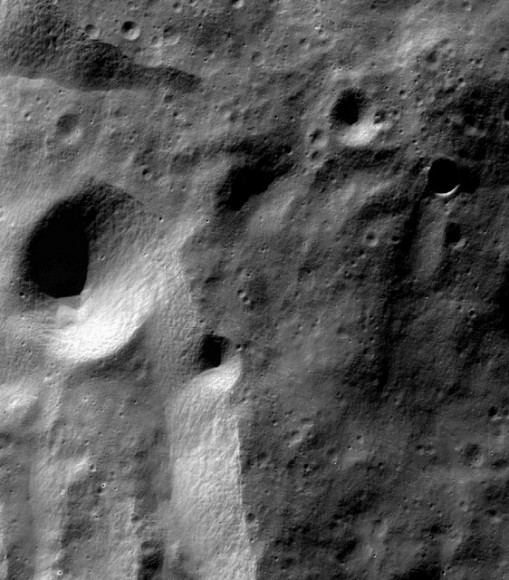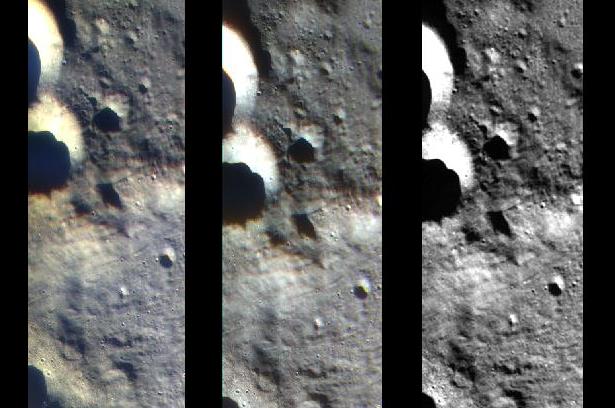[/caption]
India’s Chandrayaan-1 spacecraft has successfully sent back some of its first science data and images from the moon, but the spacecraft is also experiencing rising temperatures, and mission managers have decided to use the instruments sparingly to avoid overheating. Chandrayaan-1 is currently orbiting over the sunlit side of the moon, and a rise in temperatures inside the spacecraft was expected, but still is a cause for concern. “This rise and fall in temperature inside a satellite is a normal cyclical process,” Mylswamy Annadurai, project director of Chandrayaan-I, told a newspaper in India, The Indian Express. “There is nothing unusual about it. But since this is the first cycle being faced by Chandrayaan, we are being extra cautious. We have decided to wait till the temperatures dip to bring the mission into the operational phase.” As of now, all but two of the instruments onboard have been switched on and tested. But only one instrument at a time is being used, and the two inactive instruments won’t be turned on until engineers know spacecraft is cool enough.
But scientists released a very nice video from the Terrain Mapping Camera…
Here’s a link to the movie of images stitched together for a view of flying over the Moon. The videos at ISRO only works in Internet Explorer. Find the science images at ISRO’s site here.
During the current orbital phase the spacecraft is almost continually in the sun and experiencing ‘summer.’ The Moon also radiates heat as it receives energy from the sun. The spacecraft’s temperature is expected to stabilize by the end of December. Until then, scientists will use one instrument at a time, but hope to operate all instruments simultaneously by mid-January.
Chandrayaan-1 has a heater, which is capable of increasing the temperature during the ‘winter’ but there is no cooling mechanism. If temperatures start reaching the upper limit, there would be no option but to switch off all the instruments.

The two instruments that haven’t been turned on yet are not only more sensitive to heat but also to high voltage. One is the Swedish sub-atomic reflecting analyzer (SARA), which will image the Moon’s permanently shadowed polar regions. The other is the Indian X-ray spectrometer, HEX, which will study radioactive emissions from the lunar surface.
“We thought it would be wise to wait for the temperature to go down before testing them,” Annadurai said. The extra-cautiousness on the part of mission scientists is only because this is Chandrayaan’s first experience with such phenomenon. “We are well within the upper limit of the spacecraft’s temperature bracket. But we want to remain in this comfort zone as it is our first experience,” Annadurai added.
Chandrayaan-1 carries 11 payloads, including a Terrain Mapping Camera (TMC), Hyper Spectral Imager (HySI), Lunar Laser Ranging Instrument (LLRI), High Energy X-ray Spectrometer (HEX), Moon Impact Probe (MIP), Chandrayaan-1 X-ray Spectrometer (C1XS), Smart Near-IR Spectrometer (SIR-2), Radiation Dose Monitor Experiment (RADOM), Sub Kev Atom reflecting Analyser (SARA), Miniature Synthetic Aperture Radar (MiniSAR) and Moon Mineralogy Mapper (M3).
Source: Indian Express, ISRO


They are certainly not spending as much on “Web Coolness” as NASA does – hopefully to focus on cool science instead…. and not having to cut budgets for missions in the future.
The downside is that I have yet to see a link to one of their movies and animations that actually works – ah, well, I can live without them. Great work, so far, and I like the cautious approach – learn how to walk before you run.
The movie link provided in the article here does work in IE but not in Firefox.
Alternativly you could open the following url in windows media player: “mms://msrv2.wstream.net/isro_archive/TMC02.wmv”
The folks at ISRO have been upfront in saying their movies only work in IE. I will add that in the article above.
It looks like their mission scientists will have to be patient.
how much of rise in temperature was expected?what is the set temperature upper limit?
The mms URL is good if one cannot run Internet Explorer.
Works well with mplayer on Linux (Debian)
The nearest celestial place for us to do “terraforming” is this moon of us with its dead surface.
How strange it might be if you would look up in the sky in dark night and find its disk no longer shine in silver. Would mankind be deadly shocked if the light of the moon would change due to all-encompassing experiments?
The Moon cannot be terraformed, of course. Earth – terra – is a godsend, a unique place in the whole universe. The features of the moon, its mass and its magnetosphere, its formation are completely different, as me and everybody already knows. But could we not try to change the density of the absolute thin atmosphere of the moon a little bit at least? Terraforming need not mean to create a second Earth. Is the moon really without every resource that could be used to create something new on it?
We have a place for experiments of global dimensions right in front of our doorstep. Do we need to preserve the appearance of the Moon? Would it not be nice to arrange terrifying experiments over there? For to change the dead surface of the moon!
Good work to the Indian crew monitoring Chandrayaan1. I wish them lots of success.
I’m having difficulty understanding how the spacecraft can be in continuous sunlight (“experiencing summer”) while orbiting the moon. Shouldn’t each orbit be half and half sunlight and darkness? What am I missing?
although i am not very sure MrCurt, but i guess it has something to do with that fact that the orbital velocites and orbital period of the moon and Earth are so matched that only one surface of the moon is visible from Earth and the other side always remains in the dark, something very similar could be happening with the spacecraft – ie it might slowly be progressing towards the lunar dark side but might take half a month or more to do so, ie the lunar month being of 29 days.
am i making any sense? dont know if this helps or not.
“The nearest celestial place for us to do “terraforming” is this moon of us with its dead surface.”
A large, low-gravity but stable platform with unlimited hard vacuum over all of its surface, not very far away, no existing ecology to damage, just waiting for all kinds of research and commercial activities that would be more difficult or impossible in most other places?
Terraform Mars if you must (though I question the ethics of that, if anything already lives there), terraform Venus if you can, (good luck!) but I submit that the Moon is far more valuable to us just as it is…
the spacecraft could be orbiting in continuous sunlight if it were in a polar orbit that from our point of view here on earth would seem to trace a circle around the moon. did that make any sense?